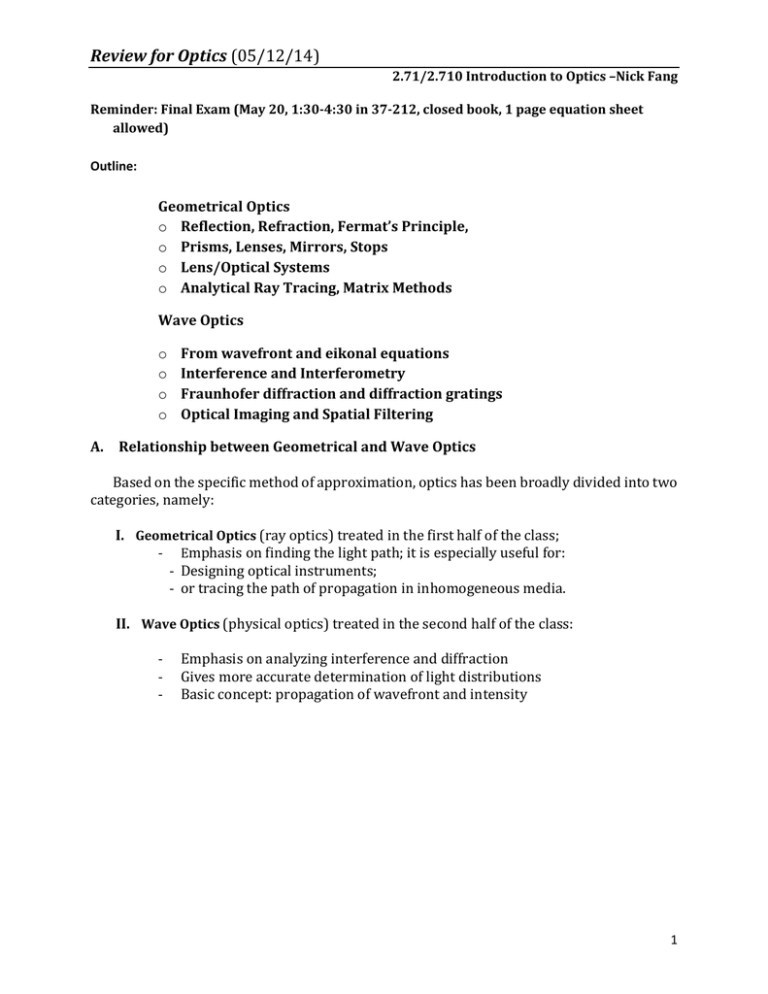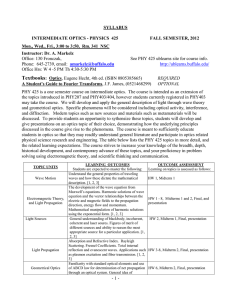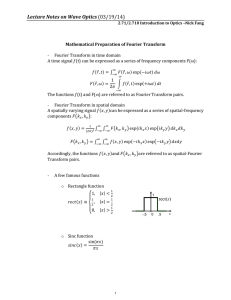
Review for Optics (05/12/14)
2.71/2.710 Introduction to Optics –Nick Fang
Reminder: Final Exam (May 20, 1:30-4:30 in 37-212, closed book, 1 page equation sheet
allowed)
Outline:
Geometrical Optics
o Reflection, Refraction, Fermat’s Principle,
o Prisms, Lenses, Mirrors, Stops
o Lens/Optical Systems
o Analytical Ray Tracing, Matrix Methods
Wave Optics
o
o
o
o
From wavefront and eikonal equations
Interference and Interferometry
Fraunhofer diffraction and diffraction gratings
Optical Imaging and Spatial Filtering
A. Relationship between Geometrical and Wave Optics
Based on the specific method of approximation, optics has been broadly divided into two
categories, namely:
I. Geometrical Optics (ray optics) treated in the first half of the class;
- Emphasis on finding the light path; it is especially useful for:
- Designing optical instruments;
- or tracing the path of propagation in inhomogeneous media.
II. Wave Optics (physical optics) treated in the second half of the class:
-
Emphasis on analyzing interference and diffraction
Gives more accurate determination of light distributions
Basic concept: propagation of wavefront and intensity
1
Review for Optics (05/12/14)
2.71/2.710 Introduction to Optics –Nick Fang
Distance of event
wavelength
Geometric
Optics
Radio
Engineering,
(Scalar) Fourier Optics
Nano-Optics
Vector Field, Polarization
Antennas,
Transmission
lines,
cavities,
amplifiers
Wavelength
min feature size
Relationship between wavefronts and rays:
z
Wavefronts:
1) A geometrical surface at which the wave phase is constant
2) As time evolves, the wavefronts propagate at the speed of wave and
expand outwards while preserving the wave’s energy.
Properties of rays:
1) Rays are normals to the wavefront surfaces
2) trajectories of “particles of light”
3) Normal to the wavefront surfaces
4) Continuous and piece-wise differentiable
5) Ray trajectories are such as to minimize the “optical path”
How can we obtain Geometric optics picture such as ray tracing from wave equations?
We can decompose the field E(r, ) into two forms: a fast oscillating component
exp(ik0), k 0 = 𝜔/𝑐0 and a slowly varying envelope E0(r).
2
Review for Optics (05/12/14)
2.71/2.710 Introduction to Optics –Nick Fang
Eikonal Equation describes the variation of wavefront :
𝜕Φ 2
𝜕Φ 2
𝜕Φ 2
( ) + ( ) + ( ) = 𝜀(𝑥, 𝑦, 𝑧) = 𝑛2 (𝑥, 𝑦, 𝑧)
𝜕𝑦
𝜕𝑧
𝜕𝑥
Associated with the transport of intensity 𝐸0 = √𝐼:
𝜕 2Φ 𝜕 2Φ 𝜕 2Φ
𝜕𝐸0 𝜕Φ 𝜕𝐸0 𝜕Φ 𝜕𝐸0 𝜕Φ
𝐸0 ( 2 +
+ 2)+ 2(
+
+
)=0
2
𝜕𝑥
𝜕𝑦
𝜕𝑧
𝜕𝑥 𝜕𝑥
𝜕𝑦 𝜕𝑦
𝜕𝑧 𝜕𝑧
-
*A precursor to Gaussian Optics (not for the finals): use a complex radius
of curvature q to mix and match of rays and wavefronts!
© Pearson Prentice Hall. All rights reserved. This content is excluded from our Creative
Commons license. For more information, see http://ocw.mit.edu/fairuse.
B. Origin of Interference (Coherence)
-
The (generalized) wavefront of a wave train varies with space and time:
δ(𝑥, 𝑦, 𝑧, 𝑡) = k 0 Φ = 𝑘𝑥 𝑥 + 𝑘𝑦 𝑦 + 𝑘𝑧 𝑧 − 𝜔𝑡 + 𝜑
The fringes of intensity suggest the similarity of the measured field over a
given time or spatial period: this property can be used to measure
correlation or degree of coherence.
Temporal coherence:
Correlation in phase of the radiation field measured at different time intervals
3
Review for Optics (05/12/14)
2.71/2.710 Introduction to Optics –Nick Fang
Spatial coherence:
Correlation in phase of the radiation field measured at different spatially distinct
points. In general, wave-fronts smooth out as they propagate away from the source.
*The van Cittert-Zernike Theorem states that
the spatial coherence area Ac is given by:
D
d
-
where d is the diameter of the light source and D
is the distance away, and = d2/D2 is the solid
angle extended by the source.
Two or more wavefronts of different sources (with same polarization) may cross
each other:
𝐸𝑥 = 𝐸1𝑥 + 𝐸2𝑥 = 𝐸1𝑥 (0) exp[𝑖𝛿1 ] + 𝐸2𝑥 (0) exp[𝑖𝛿2 ]
2 (0)
2 (0)]
𝐼 = 𝑐𝜀[𝐸1𝑥
+ 𝐸2𝑥
+ 2𝑐𝜀𝐸1𝑥 (0)𝐸2𝑥 (0)⟨cos(𝛿1 − 𝛿2 )⟩
e.g.
𝛿1 − 𝛿2 = (𝑘1 𝑠𝑖𝑛𝜃1 − 𝑘2 𝑠𝑖𝑛𝜃2 )𝑥 + (𝑘1 𝑐𝑜𝑠𝜃1 − 𝑘2 𝑐𝑜𝑠𝜃2 )𝑧 + (𝜑1 − 𝜑2 )
Image of wavefront splitting inferometry removed due to copyright restrictions.
4
Review for Optics (05/12/14)
2.71/2.710 Introduction to Optics –Nick Fang
C.
Fourier Transform and some famous functions:
∞
∞
1
𝑓(𝑥, 𝑦) =
∫ ∫ 𝐹(𝑘𝑥 , 𝑘𝑦 ) exp(𝑖𝑘𝑥 𝑥) exp(𝑖𝑘𝑦 𝑦) 𝑑𝑘𝑥 𝑑𝑘𝑦
(2𝜋)2
−∞ −∞
∞
∞
𝐹(𝑘𝑥 , 𝑘𝑦 ) = ∫ ∫ 𝑓(𝑥, 𝑦) exp(−𝑖𝑘𝑥 𝑥) exp(−𝑖𝑘𝑦 𝑦) 𝑑𝑥𝑑𝑦
−∞ −∞
Accordingly, the functions 𝑓(𝑥, 𝑦)and 𝐹(𝑘𝑥 , 𝑘𝑦 )are referred to as spatial-Fourier
Transform pairs.
Functions
𝑥
𝑟𝑒𝑐𝑡 ( )
𝑎
𝑥
𝑠𝑖𝑛𝑐 ( )
𝑎
𝑥
Λ( )
𝑎
𝑥
comb ( )
𝑎
Fourier Transform Pairs
𝑎𝑘𝑥
|𝑎|𝑠𝑖𝑛𝑐 (
)
2𝜋
𝑎𝑘𝑥
|𝑎|𝑟𝑒𝑐𝑡 (
)
2𝜋
𝑎𝑘𝑥
|𝑎|2 𝑠𝑖𝑛𝑐 2 (
)
2𝜋
𝑎𝑘𝑥
|𝑎|𝑐𝑜𝑚𝑏 (
)
2𝜋
𝑎2
𝑒𝑥𝑝 (− 𝑘𝑥 2 )
4𝜋
1
1
+ (𝛿(𝑘𝑥 ))
𝑖𝑘𝑥 2
𝑥2
Gaussian 𝑒𝑥𝑝 (− 𝑎2 )
Step function 𝐻(𝑥)
2𝜋𝐽1 (𝑎√𝑘𝑥 2 + 𝑘𝑦 2 )
√𝑥 2 + 𝑦 2
𝑐𝑖𝑟𝑐 (
)
𝑎
|𝑎|2
𝑎√𝑘𝑥 2 + 𝑘𝑦 2
D. General Diffraction Geometry:
Aperture
transmission
y
y’
Observation
plane
t(x,y)
E(x,y)
P
P’
x
x’
z
E(x’,y’)
Incident
wave-fronts
5
Review for Optics (05/12/14)
2.71/2.710 Introduction to Optics –Nick Fang
𝐸(𝑥 ′ , 𝑦 ′ ) = ∬ ℎ(𝑥 ′ − 𝑥, 𝑦 ′ − 𝑦, 𝑧)𝑡(𝑥, 𝑦)𝐸(𝑥, 𝑦)𝑑𝑥𝑑𝑦
a. Fraunhofer Diffraction:
𝑘(𝑥 2 +𝑦 2 )
2𝑧
≪ 1 (difficult to achieve!)
1
𝐸(𝑥 ′ , 𝑦 ′ ) ≈ ∬ exp(−𝑖𝑘(𝜃𝑥 ′ 𝑥 + 𝜃𝑦 ′ 𝑦))𝑡(𝑥, 𝑦)𝐸(𝑥, 𝑦)𝑑𝑥𝑑𝑦
𝑧
b. Fresnel Diffraction
2
2
𝑘(𝑥 ′ +𝑦 ′ )
𝑘(𝑥 2 +𝑦 2 )
When
~1,
~1,
2𝑧
2𝑧
we are in the domain of Fresnel Diffraction. The quadratic phase terms cannot be
neglected in the Fresnel propagator:
(𝑥 ′ − 𝑥)2 + (𝑦 ′ − 𝑦)2
exp(𝑖𝑘𝑧)
h(x, y, x , y , z) =
𝑒𝑥𝑝(𝑖𝑘
)
𝑧
2𝑧
′
′
You may recognize it is a Gaussian function with respect to x and y, and the
wavefront is diverging.
𝑧
𝑧
Using 𝑥′ = 𝑘𝑥 𝑘, 𝑦′ = 𝑘𝑦 𝑘
The corresponding transfer function is:
𝐻(𝑘𝑥 , 𝑘𝑦 ) =
𝑥2 + 𝑦2
exp(𝑖𝑘𝑧)
∬ 𝑒𝑥𝑝 (𝑖𝑘
) exp(−𝑖𝑘𝑥 𝑥 − 𝑖𝑘𝑦 𝑦) 𝑑𝑥𝑑𝑦
2𝑧
𝑧
𝑘𝑥 2 + 𝑘𝑦 2
exp(𝑖𝑘𝑧)
𝐻(𝑘𝑥 , 𝑘𝑦 ) =
𝑒𝑥𝑝 (−𝑖𝑧
)
2𝑘
𝑘
The Fourier transform of a Gaussian function is still a Gaussian function. The above
property is often used in analyzing the depth of focus (DOF).
c. Diffraction using a lens
𝑖𝑘(𝑥 2 + 𝑦 2 )
𝑡(𝑥, 𝑦) = 𝑒𝑥𝑝 [−
]
2𝑓
cancels quadratic phase terms.
𝐸𝑜𝑢𝑡 (𝑥′, 𝑦′) ≈ ∬ 𝐸𝑖𝑛 (𝑥, 𝑦)exp {
−𝑖𝑘[𝑥′𝑥 + 𝑦′𝑦]
} 𝑑𝑥𝑑𝑦
𝑓
6
Review for Optics (05/12/14)
2.71/2.710 Introduction to Optics –Nick Fang
𝑓
𝑓
𝑥′ = 𝑘𝑥 𝑘, 𝑦′ = 𝑘𝑦 𝑘 matches the Fourier transform.
d. Diffraction using a grating
∞
𝑡(𝑥) = ∑ 𝑡𝑚 𝑐𝑜𝑠 (
𝑚=0
2𝜋𝑚𝑥
)
Λ
Maximum of diffraction order occur if Λsin(𝜃𝑚 ) = 𝑚𝜆 (at normal incidence)
E.
Abbe’s theory of Imaging
image
plane
object:
decomposed into
Huygens wavelets
plane
wave
illumination
The transmission 𝐴𝑆(𝑥 ′ , 𝑦 ′ ) of the aperture stop, will contribute to the image
formation through spatial filtering at Fourier planes:
𝐴𝑆(𝑥 ′ , 𝑦 ′ ) = 𝐴𝑆(𝑘𝑥
𝑓1
𝑘
𝑓
, 𝑘𝑦 𝑘1 ) (Amplitude Transfer Function(ATF))
a. Coherent imaging (superposition of E-field)
𝑓
𝑓
ℱ [𝐴𝑆(𝑘𝑥 𝑘1 , 𝑘𝑦 𝑘1 )] is called Point Spread Function(PSF) (since it is the
spread of an ideal point source 𝛿(𝑥, 𝑦) at the image).
- The following diagram elaborate the procedure of coherent imaging as a
linear, shift invariant system.
7
Review for Optics (05/12/14)
2.71/2.710 Introduction to Optics –Nick Fang
illumination
Transparency t(x)
E(x)
convolution
𝑥
= 𝐸 𝑥 𝑡(𝑥)
=
PSF
Fourier
Transform
Fourier
Transform
Spatial
Frequency
domain
Output
amplitude
𝑜 𝑡 𝑥
𝑥
𝑆𝐹(𝑥)
multiply
𝑓𝑥
Transfer
function H(fx)
=
𝑓𝑥
𝑓𝑥 𝐻(𝑓𝑥 )
𝑜 𝑡
Transfer function H(fx) (=AS(x’)) is also called the pupil function.
b. Incoherent imaging
Under (spatially) incoherent illumination, the image intensity is a
convolution of object intensity with intensity of point spread function
(iPSF=|PSF|2). Correspondingly, the (complex) Optical Transfer Function
(OTF) is the Fourier transform of iPSF.
- The following diagram elaborate the procedure of incoherent imaging as a
linear, shift invariant system.
illumination
Transparency t(x)
I(x)
𝑥
= 𝐼 𝑥 𝑡(𝑥)
convolution
iPSF
Fourier
Transform
Fourier
Transform
Spatial
Frequency
domain
=
Output
intensity
𝑜 𝑡 𝑥
𝑥 𝑖 𝑆𝐹(𝑥)
multiply
(𝑓𝑥 )
=
𝑓𝑥
𝑓𝑥 𝐻 (𝑓𝑥 )
𝑜 𝑡
Intensity Transfer function
𝐻 (fx)=H(fx)*H(fx)
8
Review for Optics (05/12/14)
2.71/2.710 Introduction to Optics –Nick Fang
F. Aberration (not included in final exam, supplement Pedrotti Chapter 20, and for
your study only)
Very few optical systems give images that are free from all defects. Fortunately,
certain defects can be tolerated in a particular application, if the produced images
have the specified quality. Thus, experimentalists can solve optical problems in the
real world, bearing the imperfections in mind. Optical designers control the
important aberration effects by the position of stops (to minimize field curvature),
by the "bending" of components (to minimize aperture defect), or by the choice of
glasses, thicknesses, and spacing for components (to manage achromatism, etc.).
Recently, designers have been beginning to use aspheric surfaces more
extensively.
Most aberrations cannot be modeled with ray matrices. Designers beat them
with lenses of multiple elements, that is, several lenses in a row. Some zoom lenses
can have as many as a dozen or more elements.
Image Testing:
Ray tracing, to guide optical design, has been practiced since it was
introduced in the time of Newton. An optical lens system may be evaluated
before fabrication and assembly by computational ray tracing. When the lens
is constructed, it may be further evaluated by experimental testing.
Modern ray tracing is done with high-speed computing softwares so that,
for each point in the object plane, several hundred rays may be calculated,
and the points where they penetrate the image plane may be plotted to
predict the imaging characteristics. The surface density of these points in
the image plane are used to predict the performance of the optical system
with respect to the illumination condition. Often the experimental test shows
that the dot diagram predictions are pointing to the worst case scenariothat is, they predict a poorer quality of the image of a point source than
experiment limit. But despite of this lack of full agreement for ray tracing,
these computational evaluations are widely used in practice.
9
Review for Optics (05/12/14)
2.71/2.710 Introduction to Optics –Nick Fang
© Source unknown. All rights reserved. This content is excluded from our Creative
Commons license. For more information, see http://ocw.mit.edu/fairuse.
The above schematic illustrates the Hartmann test. This experimental
method for testing an optical system has much in common with theoretical
ray tracing. In the Hartmann test a screen obscures all the rays collected by
the lens, except a set of narrowly defined beams. These sampling beams are
uniformly distributed over the aperture, as illustrated. The trajectory of each
of these beams may be traced by means of a series of (digital) photographs
made at regular intervals along the optical axis in front of, and behind, their
best union, as shown.
The knife-edge test is also a kind of a ray tracing in reverse. It is evident that
by such test we may determine where rays from each part of the aperture
penetrate the focal plane. This determination follows from the position of the
knife edge and the observed location of its shadow.
10
Review for Optics (05/12/14)
2.71/2.710 Introduction to Optics –Nick Fang
Pedrotti Figure 20-1. Illustration of ray and wave aberrations.
© Pearson Prentice Hall. All rights reserved. This content is excluded from our Creative
Commons license. For more information, see http://ocw.mit.edu/fairuse.
Seidel’s Third Order Theory:
The ray optics theory for longitudinal and lateral image positions
was based on the approximate polynomial series representation of
the sinusoidal functions :
sin(𝜃) = 𝜃 −
-
𝜃3
+ 𝑂(𝜃 5 )
3!
𝜃2 𝜃4
cos(𝜃) = 1 −
+
− 𝑂(𝜃 6 )
2! 4!
The paraxial ray theory using sin = and cos() = 1is first-order
approximation. The values of , representing angles of incidence or
refraction, etc, are constrained by the paraxial approximation to have such
modest magnitudes that all higher order terms of in the expansions are
negligible. In contrast, a third-order optical theory for longitudinal and
lateral image positions which retains the third order terms in sin is first
developed around 1857 by Philip Ludwig von Seidel.
Spherical aberration (∝ 𝐫 𝟒 )
The difference in optical path length between paraxial rays and marginal
rays, proportional to the square of the lens diameter.
11
Review for Optics (05/12/14)
2.71/2.710 Introduction to Optics –Nick Fang
Example:
Pedrotti Figure 20-3: Refraction of ray at a spherical surface.
© Pearson Prentice Hall. All rights reserved. This content is excluded from our Creative
Commons license. For more information, see http://ocw.mit.edu/fairuse.
Out All
of focus
© Source unknown.
rights reserved. This content is excluded from our Creative
Commons license. For more information, see http://ocw.mit.edu/fairuse.
𝑎(𝑄) = (𝑛1 𝑙 + 𝑛2 𝑙 ′ ) − (𝑛1 𝑠 + 𝑛2 𝑠 ′ )
𝑙 2 = R2 + (s + R)2 − 2𝑅(s + R)cos𝜙
𝑙′2 = R2 + (s ′ − R)2 + 2𝑅(s ′ − R)cos𝜙
ℎ4 𝑛1 1 1 2 𝑛2 1 1 2
𝑎(𝑄) = − [ ( + ) + ′ ( ′ − ) ]
8 𝑠 𝑠 𝑅
𝑠 𝑠
𝑅
12
Review for Optics (05/12/14)
2.71/2.710 Introduction to Optics –Nick Fang
-
Coma (∝ 𝐡′𝐫 𝟑 𝒄𝒐𝒔𝜽)
A trailing "comet-like" blur directed away from the optic axis.
- image becomes increasingly blurred toward the edges;
- can be partially corrected by tilting the lens.
Figure: Coma predicted by ray tracing and as photographed (b) (redrawn from
Martin, Technical Optics) and (c) coma manifesting diffraction details (redrawn
from Kingslake, Photographic Lenses)
© Source unknown. All rights reserved. This content is excluded from our Creative
Commons license. For more information, see http://ocw.mit.edu/fairuse.
13
Review for Optics (05/12/14)
2.71/2.710 Introduction to Optics –Nick Fang
Astigmatism: (∝ 𝐡′𝟐 𝐫 𝟐 𝒄𝒐𝒔𝟐 𝜽)
The image of an off-axis point forms focal lines at the sagittal and tangential foci and
in between an elliptical shape.
Figure: Astigmatism due to a point source Q located off the optical axis.
© Source unknown. All rights reserved. This content is excluded from our Creative
Commons license. For more information, see http://ocw.mit.edu/fairuse.
Curvature of Field: (∝ 𝐡′𝟐 𝐫 𝟐 )
Curvature of field causes a planar object to project a curved (non-planar) image.
Rays at a large angle see the lens as having an effectively smaller diameter and an
effectively smaller focal length, forming the image of the off axis points closer to the
lens. This causes problems when a flat imaging device is used e.g., a photographic
plate or CCD image sensor. For more details please visit Nikon Microscopy
University:
http://www.microscopyu.com/tutorials/java/aberrations/curvatureoffield/index.h
tml
14
Review for Optics (05/12/14)
2.71/2.710 Introduction to Optics –Nick Fang
Distortion: (∝ 𝐡′𝟑 𝐫𝐜𝐨𝐬𝛉)
A radial distortion that occur from the geometry of the lens (such as thick double
convex lens).
Figure: The effect of aperture stop to control the distortion of an image.
© Source unknown. All rights reserved. This content is excluded from our Creative
Commons license. For more information, see http://ocw.mit.edu/fairuse.
15
MIT OpenCourseWare
http://ocw.mit.edu
2SWLFV
Spring 2014
For information about citing these materials or our Terms of Use, visit: http://ocw.mit.edu/terms.




